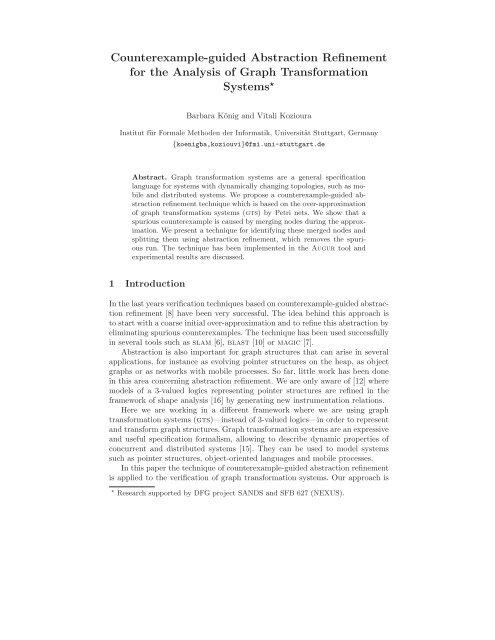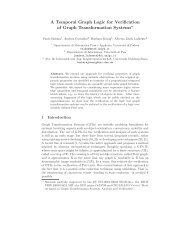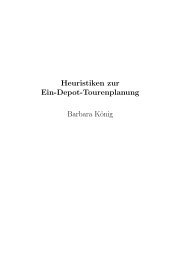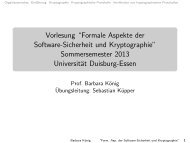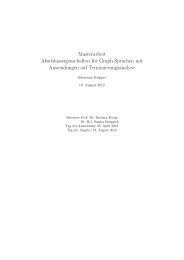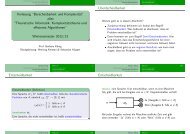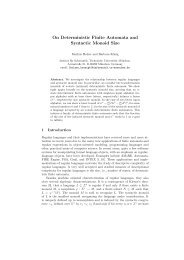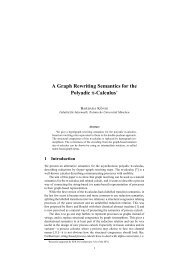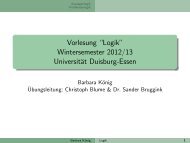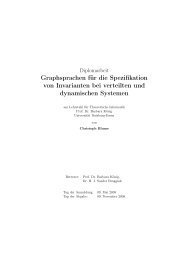Counterexample-guided Abstraction Refinement for the Analysis of ...
Counterexample-guided Abstraction Refinement for the Analysis of ...
Counterexample-guided Abstraction Refinement for the Analysis of ...
You also want an ePaper? Increase the reach of your titles
YUMPU automatically turns print PDFs into web optimized ePapers that Google loves.
<strong>Counterexample</strong>-<strong>guided</strong> <strong>Abstraction</strong> <strong>Refinement</strong><strong>for</strong> <strong>the</strong> <strong>Analysis</strong> <strong>of</strong> Graph Trans<strong>for</strong>mationSystems ⋆Barbara König and Vitali KoziouraInstitut für Formale Methoden der In<strong>for</strong>matik, Universität Stuttgart, Germany{koenigba,koziouvi}@fmi.uni-stuttgart.deAbstract. Graph trans<strong>for</strong>mation systems are a general specificationlanguage <strong>for</strong> systems with dynamically changing topologies, such as mobileand distributed systems. We propose a counterexample-<strong>guided</strong> abstractionrefinement technique which is based on <strong>the</strong> over-approximation<strong>of</strong> graph trans<strong>for</strong>mation systems (gts) by Petri nets. We show that aspurious counterexample is caused by merging nodes during <strong>the</strong> approximation.We present a technique <strong>for</strong> identifying <strong>the</strong>se merged nodes andsplitting <strong>the</strong>m using abstraction refinement, which removes <strong>the</strong> spuriousrun. The technique has been implemented in <strong>the</strong> Augur tool andexperimental results are discussed.1 IntroductionIn <strong>the</strong> last years verification techniques based on counterexample-<strong>guided</strong> abstractionrefinement [8] have been very successful. The idea behind this approach isto start with a coarse initial over-approximation and to refine this abstraction byeliminating spurious counterexamples. The technique has been used successfullyin several tools such as slam [6], blast [10] or magic [7].<strong>Abstraction</strong> is also important <strong>for</strong> graph structures that can arise in severalapplications, <strong>for</strong> instance as evolving pointer structures on <strong>the</strong> heap, as objectgraphs or as networks with mobile processes. So far, little work has been donein this area concerning abstraction refinement. We are only aware <strong>of</strong> [12] wheremodels <strong>of</strong> a 3-valued logics representing pointer structures are refined in <strong>the</strong>framework <strong>of</strong> shape analysis [16] by generating new instrumentation relations.Here we are working in a different framework where we are using graphtrans<strong>for</strong>mation systems (gts)—instead <strong>of</strong> 3-valued logics—in order to representand trans<strong>for</strong>m graph structures. Graph trans<strong>for</strong>mation systems are an expressiveand useful specification <strong>for</strong>malism, allowing to describe dynamic properties <strong>of</strong>concurrent and distributed systems [15]. They can be used to model systemssuch as pointer structures, object-oriented languages and mobile processes.In this paper <strong>the</strong> technique <strong>of</strong> counterexample-<strong>guided</strong> abstraction refinementis applied to <strong>the</strong> verification <strong>of</strong> graph trans<strong>for</strong>mation systems. Our approach is⋆ Research supported by DFG project SANDS and SFB 627 (NEXUS).
ased on a (partial order) technique that approximates gtss by Petri nets viaan unfolding construction [3]. More specifically, in this approach a finite overapproximationcalled Petri graph is constructed, which consists <strong>of</strong> a graph and aPetri net having <strong>the</strong> edges <strong>of</strong> <strong>the</strong> graph as places. The important property <strong>of</strong> <strong>the</strong>approximation obtained in this way is that each graph reachable from <strong>the</strong> startgraph in <strong>the</strong> gts can be mapped, by merging some <strong>of</strong> its nodes, to a reachablemarking <strong>of</strong> <strong>the</strong> over-approximating Petri net. On <strong>the</strong> o<strong>the</strong>r hand <strong>the</strong>re may besome markings reachable in <strong>the</strong> obtained Petri graph, which have no counterpartin <strong>the</strong> original gts. The sequence <strong>of</strong> events in <strong>the</strong> approximation leading to sucha graph is called a spurious run.In our case spurious runs are caused by <strong>the</strong> merging <strong>of</strong> graph nodes in <strong>the</strong>construction <strong>of</strong> <strong>the</strong> over-approximation. This is similar to <strong>the</strong> concept <strong>of</strong> summarynodes in shape analysis [16]. This paper describes how to construct a moreexact over-approximation by separating merged nodes <strong>for</strong> which <strong>the</strong>se spuriousruns disappear. This procedure can be per<strong>for</strong>med repeatedly <strong>for</strong> any number <strong>of</strong>spurious runs.We believe that <strong>the</strong> technique <strong>of</strong> identifying <strong>the</strong> reason <strong>for</strong> <strong>the</strong> spurious runis independent <strong>of</strong> <strong>the</strong> abstraction mechanism used in this paper and could alsobe used in o<strong>the</strong>r frameworks dealing with approximations <strong>of</strong> graph structures.The techniques presented here are implemented as an extension <strong>of</strong> <strong>the</strong> toolAugur 1 . The experimental part <strong>of</strong> <strong>the</strong> paper compares this approach with analready existing abstraction refinement technique which reduces <strong>the</strong> number <strong>of</strong>spurious examples by constructing an over-approximation which is exact up tosome pre-defined depth [5]. It is shown experimentally that counterexample<strong>guided</strong>abstraction refinement is faster and produces smaller Petri graphs.A long version <strong>of</strong> this paper is available as a technical report [11].2 Basic NotionsIn this section we describe <strong>the</strong> notions <strong>of</strong> hypergraph, gts, Petri net and Petrigraph and also show in an in<strong>for</strong>mal way how to construct over-approximatingPetri graphs.Definition 1 (hypergraphs and hypergraph morphisms). Let Λ be a set<strong>of</strong> labels where each label l ∈ Λ has an arity ar(l) ∈ N. A labelled hypergraphG is a tuple (V G ,E G ,c G ,l G ), where V G is a finite set <strong>of</strong> nodes, E G is a finiteset <strong>of</strong> edges, c G : E G → V ∗ G is a connection function and l G : E G → L is <strong>the</strong>labeling function satisfying ar(l G (e)) = |c G (e)| <strong>for</strong> every e ∈ E G . The nodes arenot labelled.Let G and G ′ be two labelled hypergraphs. A hypergraph morphism (or simplymorphism) ϕ : G 1 → G 2 consists <strong>of</strong> a pair <strong>of</strong> total functions ϕ V : V G1 → V G2and ϕ E : E G1 → E G2 such that <strong>for</strong> every e ∈ E G1 it holds that l G1 (e) =l G2 (ϕ E (e)) and ϕ V (c G1 (e)) = c G2 (ϕ E (e)). A morphism is called edge-bijective1 Available from http://www.fmi.uni-stuttgart.de/szs/tools/augur/
(edge-injective) whenever it is bijective (injective) on edges. It is an isomorphismwhenever it is bijective on nodes and edges.Hypergraphs can be rewritten using rules <strong>of</strong> <strong>the</strong> following kind.Definition 2 (rewriting rule). A rewriting rule r is a triple (L,R,α), whereL and R are hypergraphs, called left-hand side and right-hand side respectivelyand α : V L → V R is an injective mapping, indicating how nodes are preserved.We demand that <strong>the</strong>re are no isolated nodes in <strong>the</strong> left-hand side L and noisolated nodes in V R − α(V L ). Additionally E L must not be empty.The first condition says that we abstract from isolated nodes, whereas <strong>the</strong>second is a standard requirement <strong>for</strong> unfolding-based techniques, where everyrule must be consuming. Note fur<strong>the</strong>rmore that we do not consider rules thatpreserve edges <strong>of</strong> <strong>the</strong> left-hand side.For convenience we will in <strong>the</strong> following <strong>of</strong>ten assume that α is an inclusiondenoted by id, which can be en<strong>for</strong>ced by renaming <strong>the</strong> nodes <strong>of</strong> <strong>the</strong> left or righthandside appropriately, and that <strong>the</strong> node and edge sets <strong>of</strong> L and R are disjointo<strong>the</strong>rwise. That is, we demand that V L ⊆ V R and E L ∩ E R = ∅ which impliesthat <strong>the</strong> union L ∪ R is well-defined.Given a hypergraph, a rewriting rule and a match <strong>of</strong> <strong>the</strong> left-hand side, wecan apply this rule and replace <strong>the</strong> left-hand side by <strong>the</strong> right-hand side in <strong>the</strong>following way. Additionally we define a partial morphism ν from <strong>the</strong> originalgraph to <strong>the</strong> rewritten graph, keeping track <strong>of</strong> preserved nodes and edges.Definition 3 (rewriting step). Let r = (L,R,id) be a rewriting rule. A match<strong>of</strong> r in a hypergraph G is any morphism ϕ : L → G injective on edges. We canapply r to G according to <strong>the</strong> match ϕ and obtain a new graph H, written G ⇒ rH, which is defined as follows: V H = V G ⊎(V R −V L ), E H = (E G −ϕ(E L )) ⊎E Rand, defining ϕ:V R → V H by ϕ(v) = ϕ(v) if v ∈ V L and ϕ(v) = v o<strong>the</strong>rwise, <strong>the</strong>connection and labelling functions are given by c H (e) = c G (e), l H (e) = l G (e) ife ∈ E G − ϕ(E L ) and c H (e) = ϕ(c R (e)), l H (e) = l R (e) if e ∈ E R .We also define an injective partial morphism ν : G → H where ν V : V G → V Hand ν E : (E G − ϕ(E L )) → E H with ν(x) = x <strong>for</strong> every node or edge x.A graph trans<strong>for</strong>mation system (gts) G = (R,G 0 ) is a finite set <strong>of</strong> rulestoge<strong>the</strong>r with a start hypergraph (also called initial graph).Example: We illustrate <strong>the</strong> definitions <strong>of</strong> this chapter with an example describinga firewall system similar to <strong>the</strong> one introduced in [4]. This system contains an(arbitrarily large) set <strong>of</strong> processes running behind a firewall (safe processes) andone process in a public area (unsafe process). Any number <strong>of</strong> safe processes (SP)and connected locations (L) can be generated during runtime. The property toverify is that <strong>the</strong> unsafe process from <strong>the</strong> public area does not penetrate <strong>the</strong>firewall. If this situation is detected, rule “Error” will be applied and an edgelabelled Error is created.Fig. 1 and Table 1 depict <strong>the</strong> initial graph and <strong>the</strong> rules <strong>of</strong> <strong>the</strong> firewall system.A double-headed arrow in a rule means that <strong>the</strong> rule can be applied in both
directions. Numbers close to <strong>the</strong> nodes indicate <strong>the</strong> mapping α. The private andpublic areas are connected by <strong>the</strong> firewall (F), and initially <strong>the</strong>re is one unsafeprocesses (UP) in <strong>the</strong> public area. Only safe processes will be generated and<strong>the</strong> firewall can be crossed in one direction only. Our aim is to show that noreachable graph contains <strong>the</strong> 0-ary edge Error.UPv 1Lw 1Fw 2Lv 2Fig. 1. Initial graph <strong>of</strong> <strong>the</strong> firewall system.Create ProcessSPSP/UPCross LocationSP/UPL1 2 1 2Cross ConnectionSP/UPSP/UPC1 2 1 2LLCCreate Connected LocationL1 2LC1 2LL1 2 1 2Cross FirewallSP/UPF1 2 1 2UPF1 2ErrorUPFFSP/UPError1 2Table 1. Rules <strong>of</strong> <strong>the</strong> firewall system.In order to approximate gtss we will employ Petri nets, which, as multisetrewriting systems, can be seen as a special case <strong>of</strong> graph rewriting. Petrinets are an easier model than gts and hence more amenable to analysis. Severalalgorithms and tools are available <strong>for</strong> <strong>the</strong>ir verification. Fur<strong>the</strong>rmore, byapproximating with Petri nets we will be able to preserve nice properties <strong>of</strong><strong>the</strong> gts model, such as locality (state changes are only described locally) andconcurrency (no unnecessary interleaving <strong>of</strong> events) in <strong>the</strong> approximation.We will now introduce a notation <strong>for</strong> Petri nets. 22 By A ⊕ we denote a multiset over A and <strong>for</strong> a function f : A → B we denote byf ⊕ : A ⊕ → B ⊕ its extension to multisets. Fur<strong>the</strong>rmore <strong>for</strong> m ∈ A ⊕ and a ∈ A wedenote by m(a) <strong>the</strong> multiplicity <strong>of</strong> a in m.
Definition 4 (Petri net). Let ∆ be a finite set <strong>of</strong> labels. A ∆-labelled Petrinet is a tuple N = (S,T, • (),() • ,p), where S is <strong>the</strong> set <strong>of</strong> places, T is a set <strong>of</strong>transitions, • (),() • : T → S ⊕ assign to each transition its pre-set and post-setand p : T → ∆ assigns a label to each transition. A marked Petri net is a pair(N,m N ), where N is a Petri net and m N ∈ S ⊕ is <strong>the</strong> initial marking.3 Approximated UnfoldingIn this section we will give a short overview <strong>of</strong> a technique that approximatesa graph trans<strong>for</strong>mation system by a structure that is both a Petri net and ahypergraph [3–5].First we define <strong>the</strong> notion <strong>of</strong> Petri graph which will be used to represent anover-approximation <strong>for</strong> a given gts. Note that <strong>the</strong> edges <strong>of</strong> <strong>the</strong> graph are at <strong>the</strong>same time <strong>the</strong> places <strong>of</strong> <strong>the</strong> net and that <strong>the</strong> transitions are labelled with rules<strong>of</strong> <strong>the</strong> gts.Definition 5 (Petri graph). Let G = (R,G 0 ) be a gts. A Petri graph (overR) is a tuple P = (G,N,µ), where G is a hypergraph, N = (E G ,T N , • (),() • ,p N )is an R-labelled Petri net where <strong>the</strong> places are <strong>the</strong> edges <strong>of</strong> G and µ associatesto each transition t ∈ T N , with p N (t) = (L,R,id), a hypergraph morphismµ(t) : L ∪ R → G such that • t = µ(t) ⊕ (E L ) and t • = µ(t) ⊕ (E R ).A Petri graph <strong>for</strong> <strong>the</strong> gts G is a pair (P,ι), where P = (G,N,µ) is a Petrigraph over R and ι : G 0 → G is a graph morphism. A marking is reachable(coverable) in Petri graph if it is reachable (coverable) in <strong>the</strong> underlying Petrinet with <strong>the</strong> multiset ι ⊕ (E G0 ) as <strong>the</strong> initial marking.We view Petri graphs as symbolic representations <strong>of</strong> transition systems withgraphs as states. Specifically each marking m <strong>of</strong> a Petri graph (G,N,m 0 ) canbe seen as representation <strong>of</strong> a graph, denoted by graph(m), according to <strong>the</strong>following definition: We take <strong>the</strong> marked subgraph <strong>of</strong> G and duplicate each edgeas indicated by <strong>the</strong> marking.Alternatively one can define graph(m) as <strong>the</strong> unique graph H, up to isomorphism,such that H has no isolated nodes and <strong>the</strong>re exists a morphismψ : H → G, injective on nodes, with ψ ⊕ (E H ) = m. Fur<strong>the</strong>rmore, whenever<strong>the</strong>re exists a morphism ϕ : G ′ → G such that ϕ ⊕ (E G ′) ≤ m, <strong>the</strong>n <strong>the</strong>re existsan edge-injective morphism e m,ϕ :G ′ → graph(m) such that ψ ◦ e m,ϕ = ϕ.In order to obtain a Petri graph approximating a gts, we first need—asbuilding blocks—Petri graphs that describe <strong>the</strong> effect <strong>of</strong> a single rule.Definition 6 (Petri graph <strong>for</strong> a rewriting rule). Let r = (L,R,id) be arewriting rule. By P(t,r) = (G,N,µ) we denote a Petri graph with G = L∪R andN is a net with places S N = E L ∪ E R and one transition t such that p N (t) = r,• t = E L and t • = E R . Fur<strong>the</strong>rmore <strong>the</strong> morphism µ(t):L∪R → G is <strong>the</strong> identity.Given a gts G = (R,G 0 ) one can construct an over-approximating Petrigraph C G (also called <strong>the</strong> covering <strong>of</strong> G), using <strong>the</strong> following algorithm (see
[3]). It starts with a Petri graph P 0 that consists only <strong>of</strong> <strong>the</strong> start graph andcomputes C G iteratively. It is based on an unfolding technique which is combinedwith over-approximating folding steps which guarantee a finite approximation.Algorithm 7 (approximated unfolding) We set P 0 = (G 0 ,N 0 ,m 0 ), whereN 0 contains no transitions, m 0 = E G0 and let ι 0 :G 0 → G 0 be <strong>the</strong> identity. Aslong as one <strong>of</strong> <strong>the</strong> following steps is applicable, trans<strong>for</strong>m P i into P i+1 accordingto <strong>the</strong> possibilities given below (where folding steps take precedence overunfolding steps).Unfolding: Find a rule r = (L,R,id) ∈ R and a match ϕ : L → G i . Then choosea new transition t and extend P i by attaching P(t,r), i.e., take <strong>the</strong> disjoint union<strong>of</strong> both Petri graphs and factor through <strong>the</strong> equivalence ≡ generated by e ≡ ϕ(e)<strong>for</strong> every e ∈ E L .Folding: Find a rule r = (L,R,id) ∈ R and two matches ϕ,ϕ ′ : L → G isuch that ϕ ⊕ (E L ) and ϕ ′⊕ (E L ) are coverable in N i and <strong>the</strong> second match iscausally dependent on <strong>the</strong> transition unfolding <strong>the</strong> first match. Then merge <strong>the</strong>two matches by setting ϕ(e) ≡ ϕ ′ (e) <strong>for</strong> each e ∈ E L and factoring through <strong>the</strong>resulting equivalence relation ≡.If nei<strong>the</strong>r possibility applies <strong>the</strong> Petri graph P i obtained in <strong>the</strong> last step isreturned. The result is denoted by C G . In [3] it has been shown that <strong>the</strong> algorithmalways terminates with a result unique up to isomorphism.In our running example, <strong>the</strong> constructed over-approximation consists <strong>of</strong> <strong>the</strong>hypergraph in Fig. 2 and <strong>the</strong> Petri net in Fig. 3. (Ignore <strong>the</strong> highlighted transitions<strong>for</strong> <strong>the</strong> moment.) Note that <strong>the</strong> set <strong>of</strong> edges <strong>of</strong> <strong>the</strong> graph correspondsexactly to <strong>the</strong> set <strong>of</strong> places <strong>of</strong> <strong>the</strong> net (<strong>the</strong> correspondence is indicated by givingindices to <strong>the</strong> labels).CSP 2UP 2v 1,2 L w 1,2SP 1UP 1FErrorFig. 2. Hypergraph component <strong>of</strong> <strong>the</strong> approximating Petri graph (firewall example).Be<strong>for</strong>e we can show in what way Petri graphs can be considered as abstractions<strong>of</strong> gtss and be<strong>for</strong>e we discuss how <strong>the</strong>y can be analyzed, we first need <strong>the</strong>definition <strong>of</strong> an abstract run <strong>of</strong> a gts and a notion <strong>of</strong> correspondence <strong>of</strong> twoabstract runs. Then we can define how Petri graphs can be seen as abstractions<strong>of</strong> gtss.
Cross FirewallErrorErrorF SP 2LCrossFirewall CrossLocationCross LocationCreateProcessSP 1UP 2CrossConnectionCreateCreate LocationLocationCrossLocationC UP 1CrossLocationFig. 3. Petri net component <strong>of</strong> <strong>the</strong> approximating Petri graph (firewall example).Definition 8 (Abstract run). An abstract run <strong>of</strong> a gts (R,G 0 ) is a sequence<strong>of</strong> hypergraphs J = (J 0 ⇛ r1 J 1 ⇛ r2 ... ⇛ rn J n ), where r i is a rule name,toge<strong>the</strong>r with morphisms ϕ i : L i+1 → J i <strong>for</strong> each i = 1,...,n−1, where L i is <strong>the</strong>left-hand side <strong>of</strong> rule r i ∈ R.Note that we do not demand that J i can be derived from J i−1 by applyingrule r i at match ϕ i . In this case J will be called a real run and we will also use<strong>the</strong> symbol ⇒ instead <strong>of</strong> ⇛.Let J ′ = (J 0 ′ ⇛ r1 J 1 ′ ⇛ r2 ... ⇛ rn J n) ′ be ano<strong>the</strong>r abstract run with morphismsϕ ′ i :L i+1 → J i ′ <strong>for</strong> each i = 1,...,n−1. We say that J ′ weakly correspondsto J (in symbols J ′ ≪ J ) if <strong>for</strong> each i = 1,...,n−1 <strong>the</strong>re exist edgebijectivemorphism ξ i : J i ′ → J i <strong>for</strong> i = 0,...,n. If fur<strong>the</strong>rmore <strong>the</strong> followingdiagram commutes we say that J ′ corresponds to J and write J ′ ≪ J .ϕ ′ iL i+1J iϕ iJ ′ iξ iPetri graphs can, as mentioned above, be seen as symbolic representations <strong>of</strong>graph transition systems and also as representations <strong>of</strong> sets <strong>of</strong> abstract runs.Definition 9 (Abstract runs <strong>of</strong> a Petri graph). Let (P,ι) with P = (G,N,µ)be a Petri graph <strong>for</strong> a gts (R,G 0 ). Fur<strong>the</strong>rmore let m 0 [t 1 〉...[t n 〉m n be a firingsequence <strong>of</strong> <strong>the</strong> net N and let r i = p N (t i ) be <strong>the</strong> rules corresponding to <strong>the</strong>transitions. We define morphisms ϕ i = e mi,µ(t i+1)| Li+1: L i+1 → graph(m i ),where L i+1 is <strong>the</strong> left-hand side <strong>of</strong> rule r i+1 . The sequence graph(m 0 ) ⇛ r1graph(m 1 ) ⇛ r2 ... ⇛ rn graph(m n ) toge<strong>the</strong>r with <strong>the</strong> morphisms ϕ i is an abstractrun. We denote by Run A (P,ι) <strong>the</strong> set <strong>of</strong> all abstract runs <strong>of</strong> <strong>the</strong> Petrigraph (P,ι).Each real run J r = (G 0 ⇒ r1 G 1 ⇒ r2 ... ⇒ rn G n ) <strong>of</strong> <strong>the</strong> gts (R,G 0 ) can beconsidered as an abstract run where <strong>the</strong> ϕ i : L i+1 → G i represent <strong>the</strong> matches<strong>of</strong> <strong>the</strong> left-hand sides <strong>of</strong> <strong>the</strong> rules r i .
Proposition 1. Let C G be an over-approximation <strong>for</strong> a gts G computed byAlgorithm 7. Then, <strong>for</strong> every real run J r <strong>of</strong> <strong>the</strong> graph trans<strong>for</strong>mation system<strong>the</strong>re exists an abstract run J ∈ Run A (C G ) such that J r corresponds to J , i.e.,J r ≪ J .An abstract run J <strong>for</strong> which <strong>the</strong>re does not exist a real run correspondingto J is called spurious. If, at <strong>the</strong> same time, it violates <strong>the</strong> property we attemptto verify, it is called a counterexample or error trace.We can now verify <strong>the</strong> gts by analyzing <strong>the</strong> Petri graph underlying <strong>the</strong> Petrinet. For instance, in order to show that no reachable graph contains a subgraphG s we add a new rule to <strong>the</strong> gts with G s as left-hand side and an edge witha new label Error in <strong>the</strong> right-hand side (see rule “Error” in Table 1). If wecan show that ei<strong>the</strong>r no place labelled Error exists in <strong>the</strong> net or every suchplace is not coverable (this can be done using coverability graphs or backwardreachability algorithms [1]), <strong>the</strong>n we can deduce that this property holds.However, if <strong>the</strong> approximation is too coarse, we might not be able to verify<strong>the</strong> property. We have shown in [5] how to construct a sequence <strong>of</strong> subsequentlybetter unfolding—which however grow in size fairly rapidly—by <strong>for</strong>bidding foldingsteps up to depth k. There<strong>for</strong>e we will now show how to successfully apply <strong>the</strong>technique <strong>of</strong> counterexample-<strong>guided</strong> abstraction refinement in our framework.4 <strong>Abstraction</strong> <strong>Refinement</strong>In order to eliminate spurious runs, we will show that <strong>the</strong>y are always causedby <strong>the</strong> fact that certain nodes were merged. We will identify <strong>the</strong>se nodes andshow how to avoid <strong>the</strong>ir being merged in <strong>the</strong> next iteration, <strong>the</strong>reby avoidingthis particular spurious run and all o<strong>the</strong>r abstract runs corresponding to it ina sense made precise later. Merging <strong>of</strong> nodes is harmful since it might producenew left-hand sides, <strong>the</strong>reby leading to additional rewriting steps.4.1 Spurious RunsFor a given abstract run J = (graph(m 0 ) ⇛ r1 graph(m 1 ) ⇛ r2 ... ⇛ rngraph(m n )) <strong>of</strong> <strong>the</strong> Petri graph with morphisms ϕ i : L i+1 → graph(m i ) we defineH to be <strong>the</strong> set <strong>of</strong> real runs corresponding to <strong>the</strong> prefixes <strong>of</strong> J . Fur<strong>the</strong>rmore letH i be <strong>the</strong> set <strong>of</strong> hypergraphs reachable after i steps in a real run J r ∈ H. Itholds that H 0 = {G 0 }.An abstract run J is spurious if H n = ∅. If <strong>the</strong> run is spurious, <strong>the</strong>re existsa k such that H k ≠ ∅, but H k+1 = ∅ (and <strong>the</strong>re<strong>for</strong>e also H l = ∅ <strong>for</strong> l > k). It willbe shown in <strong>the</strong> following how to construct a new refined over-approximationC G ′ , which does not contain J and some o<strong>the</strong>r spurious runs corresponding to J .Example: We illustrate <strong>the</strong> idea <strong>of</strong> a spurious abstract run with <strong>the</strong> run correspondingto <strong>the</strong> firing <strong>of</strong> <strong>the</strong> highlighted transitions “Cross Location” and “Error”in Fig. 3. In fact, <strong>the</strong>re is not real run in <strong>the</strong> original gts that correspondsto it.
4.2 Relations on Nodes <strong>for</strong> Refining Abstract RunsAccording to Algorithm 7 and Definition 8 it holds that H k ≠ ∅ and H k+1 = ∅if and only if <strong>for</strong> each G ∈ H k <strong>the</strong>re exists no edge-injective morphism η :L k+1 → G such that <strong>the</strong> following diagram commutes, where ξ k is an edgebijectivemorphism derived from <strong>the</strong> correspondence property (see Definition 8).In o<strong>the</strong>r words: <strong>the</strong>re is no way to find a match <strong>of</strong> <strong>the</strong> left-hand side in G thatagrees with <strong>the</strong> abstract run.L k+1ηG ξ k graph(m k )ϕ kFor if <strong>the</strong>re were such a match morphism η, we could rewrite G to G ′ withrule r k+1 corresponding to <strong>the</strong> transition trans<strong>for</strong>ming m k to m k+1 . Because <strong>of</strong><strong>the</strong> construction <strong>of</strong> <strong>the</strong> Petri graph, where <strong>the</strong> right-hand side <strong>of</strong> r i+1 has beenattached during an unfolding step, we would <strong>the</strong>n be able to find an edge-bijectivemorphism ξ k+1 :G ′ → graph(m k+1 ) thus continuing <strong>the</strong> correspondence.Such a situation is only possible if ξ k is non-injective on some nodes <strong>of</strong> G,i.e., <strong>the</strong>se nodes were merged during construction <strong>of</strong> <strong>the</strong> over-approximation C G ,which is <strong>the</strong> reason <strong>for</strong> <strong>the</strong> spurious run.Example: In our running example (see Fig. 1 and 2) <strong>the</strong> nodes v 1 and v 2 aswell as w 1 and w 2 <strong>of</strong> <strong>the</strong> initial hypergraph have been merged by <strong>the</strong> overapproximation,becoming v 1,2 and w 1,2 . This led to <strong>the</strong> spurious abstract rundescribed above.We will now show how to determine <strong>the</strong> node merges which caused <strong>the</strong> spuriousrun. Consider, <strong>for</strong> a fixed graph G and a morphism ξ k , <strong>the</strong> set Θ <strong>of</strong> possibleequivalence relations ∼ on nodes <strong>for</strong> a graph G ∈ H k such that, after merging<strong>the</strong> nodes in each equivalence class, we can find an appropriate match <strong>of</strong> <strong>the</strong>left-hand side L k+1 in <strong>the</strong> graph G/ ∼ . More <strong>for</strong>mally, we demand <strong>the</strong> existence<strong>of</strong> an edge-injective morphism η ′ : L k+1 → G/ ∼ such that <strong>the</strong> following diagramcommutes, where ξ ′ k : G/ ∼ → graph(m k ) is obtained by quotienting ξ k accordingto ∼.L k+1η ′ ξ ′ kG/ ∼ graph(m k )ϕ kIn order to characterize <strong>the</strong> smallest equivalence in Θ consider a node v <strong>of</strong> <strong>the</strong>left-hand side and determine a set Q v <strong>of</strong> nodes in G which have to be fused intoone node which is <strong>the</strong> image <strong>of</strong> v under η ′ . Let v ∈ V Lk+1 and let e be an edge<strong>of</strong> L k+1 with 3 c i (e) = v <strong>for</strong> some i. For every edge e ′ in G with ξ k (e ′ ) = ϕ k (e)we require that c i (e ′ ) ∈ Q v .Consider <strong>the</strong> relation Q, where <strong>for</strong> each v ∈ V Lk+1 all nodes in Q v are relatedand <strong>the</strong> relation ̂Q which is <strong>the</strong> smallest equivalence containing Q.3 Note that by c i(e) we denote <strong>the</strong> i-<strong>the</strong> node in <strong>the</strong> sequence c(e).
Proposition 2. The equivalence ̂Q constructed above is <strong>the</strong> smallest equivalencecontained in Θ.Example: We consider again <strong>the</strong> abstract error trace J which can be obtainedby firing transitions “Cross Location” and “Error”. However, this error trace hasno real runs that correspond to it, which can be seen by computing <strong>the</strong> set H<strong>of</strong> runs corresponding to prefixes <strong>of</strong> J . Here, <strong>the</strong> set H 0 consists <strong>of</strong> <strong>the</strong> initialhypergraph and <strong>the</strong> set H 1 contains one graph G 1 . The next rule “Error” cannotbe applied to G 1 in such a way that <strong>the</strong> corresponding diagram commutes and<strong>the</strong>re<strong>for</strong>e <strong>the</strong> set H 2 is empty.Fig. 4 shows <strong>the</strong> left-hand side <strong>of</strong> rule “Error”, G 1 ∈ H 1 and graph(m 1 ), <strong>the</strong>graph corresponding to <strong>the</strong> marking reached after one step. One notices thatno appropriate morphism η can be found unless <strong>the</strong> nodes w 1 and w 2 in G 1are merged. There<strong>for</strong>e we have Q w ′1= {w 1 ,w 2 }, Q w ′2= {w 2 } and <strong>the</strong> smallestequivalence relation ̂Q relates <strong>the</strong> nodes w 1 and w 2 and no o<strong>the</strong>r nodes. Note<strong>for</strong> instance that w 2 must be contained in Q w ′1since both are attached to <strong>the</strong>unary edge labelled UP.left-hand side <strong>of</strong> rule ”Error”L 2UPFw ′ 1 w ′ 2η”real graph” G 1 graph(m 1 ) (graph generated by m 1 )UPL F Lv 1 w 1 w 2 v 2ξw 1,2UPLLv 1,2ϕFFig. 4. Hypergraphs G 1 ∈ H 1, L 2 and graph(m 1) from <strong>the</strong> firewall example.4.3 Elimination <strong>of</strong> Spurious RunsThe general idea <strong>for</strong> destroying spurious runs is to avoid <strong>the</strong> merging <strong>of</strong> nodesfrom <strong>the</strong> same equivalence class <strong>of</strong> ̂Q. For this reason we assign colours to <strong>the</strong>nodes <strong>of</strong> <strong>the</strong> graphs contained in H and disallow <strong>the</strong> merging <strong>of</strong> nodes correspondingto nodes with <strong>the</strong> same colour. For reasons that will become clearbelow a node may have several colours, i.e., a node v is associated to a set cols(v)<strong>of</strong> colours.For each G ∈ H k we and each morphism ξ k : G → graph(m k ) we consider<strong>the</strong> corresponding relation Q G,ξk . Then we assign colours to nodes in such away that <strong>the</strong>re exists at least one pair v 1 ,v 2 <strong>of</strong> nodes such that v 1 Q G,ξk v 2 andcols(v 1 ) ∩ cols(v 2 ) ≠ ∅. There are several ways to do this and all <strong>of</strong> <strong>the</strong>m willhelp to eliminate <strong>the</strong> counterexample. In our implementation we choose a color<strong>for</strong> each set <strong>of</strong> nodes Q v and assign it to all nodes contained in Q v .In order to catch “bad” mergings as early as possible, <strong>the</strong>se colours have tobe distributed to <strong>the</strong> remaining graphs contained in H. Let us recall here that
according to Definition 3 <strong>for</strong> each real run J r = (G 0 ⇒ r1 G 1 ... ⇒ rk G k ) fromH we have injective partial morphisms ν i : G i → G i+1 <strong>for</strong> i = 0,...,k−1. Using<strong>the</strong>se partial morphisms we assign <strong>the</strong> colours <strong>of</strong> G k to <strong>the</strong> remaining graphs G icontained in H. We start from G k and proceed as follows: if a node v ∈ G i+1 hasa colour <strong>the</strong>n we also assign this colour to <strong>the</strong> node ν −1 (v) if such a node exists.In this way a node may obtain several colours, due to <strong>the</strong> branching structure<strong>of</strong> <strong>the</strong> runs contained in H. We denote by cols(v) <strong>the</strong> set <strong>of</strong> colours <strong>of</strong> <strong>the</strong> nodev ∈ V Gj where G j ∈ H j .We are now ready to give <strong>the</strong> algorithm <strong>for</strong> computing <strong>the</strong> refined overapproximation.Algorithm 10 (Refined approximated unfolding)Input: A gts G, a set H <strong>of</strong> runs corresponding to prefixes <strong>of</strong> <strong>the</strong> counterexampleand a function cols assigning sets <strong>of</strong> colours to <strong>the</strong> nodes <strong>of</strong> <strong>the</strong> graphs in H.Output: The refined over-approximation C ′ G .We start constructing <strong>the</strong> new over-approximation C G ′ with <strong>the</strong> initial graphG 0 . Unfolding steps will be per<strong>for</strong>med as described in Algorithm 7.For a folding step we disallow <strong>the</strong> merging <strong>of</strong> nodes corresponding to nodes inH having <strong>the</strong> same colour. More specifically, consider <strong>the</strong> over-approximation C G ′ ,which is currently being constructed. Now <strong>for</strong> each run J r = G 0 ⇛ r1 ... ⇛ rl G lin H where l < k check <strong>the</strong> following:We consider all abstract runs J = graph(m 0 ) ⇛ r1 ... ⇛ rl graph(m l ) <strong>of</strong> <strong>the</strong>current Petri graph C G′ <strong>for</strong> which J r ≪ J and all edge-bijective morphismsξ:G i → graph(m i ) <strong>for</strong> i = 0,...,l. Whenever <strong>the</strong>re are two nodes v 1 ,v 2 in G iwith cols(v 1 ) ∩ cols(v 2 ) ≠ ∅ and ξ(v 1 ) = ξ(v 2 ), we have erroneously merged twonodes in <strong>the</strong> approximation which should not have been merged. Consequentlythis folding step is undone.Previously rejected folding steps are recorded and are not any more consideredby <strong>the</strong> algorithm.In this way we will eliminate not only <strong>the</strong> spurious run but several more runswhich are characterized below (see Proposition 5).Example: Fig. 5 depicts <strong>the</strong> hypergraph obtained <strong>for</strong> <strong>the</strong> firewall example after<strong>the</strong> abstraction refinement procedure. As one can see, <strong>the</strong> “critical nodes” <strong>of</strong> <strong>the</strong>hypergraph, namely <strong>the</strong> nodes w 1 and w 2 , are now separated.4.4 CorrectnessIn <strong>the</strong> following we will show that Algorithm 10 terminates and that <strong>the</strong> refinedover-approximation is correct and more exact <strong>the</strong>n <strong>the</strong> previous one.Let C G be an over-approximation with a spurious run J and let C G ′ be <strong>the</strong>corresponding refined over-approximation. In [3] it is shown that <strong>the</strong> algorithmconstructing <strong>the</strong> over-approximating Petri graph terminates. We modified <strong>the</strong>algorithm by <strong>for</strong>bidding some <strong>of</strong> <strong>the</strong> folding steps and hence we have to reprovetermination <strong>for</strong> <strong>the</strong> new version <strong>of</strong> <strong>the</strong> algorithm.
SPCv 1L F Lw 1 w v 22UPSP UP SP SPCFig. 5. Hypergraph obtained after abstraction refinement.Proposition 3. The algorithm computing <strong>the</strong> refined over-approximation C ′ G <strong>for</strong>a given gts G and a (spurious) abstract run J <strong>of</strong> C G terminates.Fur<strong>the</strong>rmore <strong>the</strong> new over-approximation is still a valid over-approximationas be<strong>for</strong>e.Proposition 4. Let C G ′ be <strong>the</strong> refined over-approximation <strong>of</strong> <strong>the</strong> gts. Then, <strong>for</strong>every real run J r <strong>of</strong> <strong>the</strong> graph trans<strong>for</strong>mation system <strong>the</strong>re exists an abstract runJ ∈ Run A (C G ′ ) such that J r corresponds to J , i.e., J r ≪ J .In <strong>the</strong> following two propositions we will show that we have eliminated <strong>the</strong>given spurious counterexample and have not added any new ones. First we shouldanswer <strong>the</strong> following question: what kind <strong>of</strong> runs have we eliminated by abstractionrefinement? It is easy to see that in <strong>the</strong> refined over-approximation we havelost <strong>the</strong> initial spurious counter-example J . In fact we have not only eliminatedJ , but some more runs as described below.Definition 11 (Correspondence with respect to runs). Let (P,ι) and(P ′ ,ι ′ ) be two Petri graphs <strong>for</strong> a gts (R,G 0 ). Fur<strong>the</strong>rmore let J ∈ Run A (P,ι)and J ′ ∈ Run A (P ′ ,ι ′ ) be two abstract runs <strong>of</strong> <strong>the</strong>se Petri graphs and let H be<strong>the</strong> set <strong>of</strong> real runs considered earlier. We say that J ′ corresponds to J withrespect to H if J ′ corresponds to J and a run J ′′ ∈ H <strong>of</strong> maximal length weaklycorresponds to a prefix <strong>of</strong> J ′ .Using this definition we can now state and prove <strong>the</strong> following propositions.Proposition 5. The refined over-approximation C G ′ , constructed above does notcontain any run J ′ corresponding to <strong>the</strong> spurious run J <strong>of</strong> C G with respect toH.We can also show that no new spurious runs have appeared, which meansthat <strong>the</strong> new approximation is strictly better than <strong>the</strong> old one.Proposition 6. If <strong>the</strong> refined over-approximation C G ′ contains a spurious runJ ′ , <strong>the</strong>n it corresponds to some spurious run J in C G .We remark that <strong>the</strong> considered abstraction refinement approach can also beimplemented in <strong>the</strong> case <strong>of</strong> any number <strong>of</strong> spurious counterexamples by iterativelyrefining <strong>the</strong> abstraction. Naturally, due to undecidability and <strong>the</strong> factthat gtss are in general Turing-complete, <strong>the</strong>re is no guarantee that it will everterminate.
5 Implementation and Experimental ResultsIn this section we consider examples <strong>of</strong> gtss and compare <strong>the</strong> experimentalresults obtained by refining <strong>the</strong> approximation by <strong>for</strong>bidding folding steps up toa certain depth (see [5]) and counterexample-<strong>guided</strong> abstraction refinement aspresented in this paper. It is shown that <strong>for</strong> practical purposes <strong>the</strong> new techniqueis usually more efficient.The algorithm was implemented in C++ under Linux and <strong>the</strong> computerparameters are 2*Xeon 2.4 GHz, 2 GB RAM.For case studies we have chosen two distributed systems: <strong>the</strong> running example<strong>of</strong> this paper (firewall example) and a system <strong>of</strong> public and private servers (<strong>for</strong>a description <strong>of</strong> <strong>the</strong> second example see [11]). If we compare <strong>the</strong> results in Tables2 and 3 it can be seen that in <strong>the</strong> case <strong>of</strong> counterexample-<strong>guided</strong> abstractionrefinement we have an advantage both in runtime <strong>for</strong> computing <strong>the</strong> approximationand in <strong>the</strong> size <strong>of</strong> <strong>the</strong> over-approximations, which are consequently easier toanalyze. The difference is especially pronounced <strong>for</strong> versions II, which use largerstart graphs.The efficiency <strong>of</strong> <strong>the</strong> abstraction refinement approach can be explained by <strong>the</strong>fact that we <strong>for</strong>bid to merge only those parts <strong>of</strong> <strong>the</strong> unfolding which are responsible<strong>for</strong> <strong>the</strong> spurious counterexample. This means that <strong>the</strong> over-approximationremains ra<strong>the</strong>r compact compared to <strong>the</strong> depth-based (or k-covering) approach,where we are not allowed to merge all items having depth smaller than k. Notethat <strong>for</strong> <strong>the</strong> firewall example it was not possible to verify <strong>the</strong> properties using<strong>the</strong> depth-based approached.examplek (depth) nodes edges transitions time (sec) verifiedPublic/private servers I 0 1 9 13 0.05 noPublic/private servers I 1 2 19 34 0.72 yesPublic/private servers II 0 1 10 14 0.05 noPublic/private servers II 1 1 11 16 0.07 noPublic/private servers II 2 3 31 63 7.16 yesFirewall I 0 2 8 13 0.05 noFirewall I 1 6 25 50 2.4 noFirewall I 2 10 51 148 138.18 noFirewall II 0 2 8 13 0.14 noFirewall II 1 8 39 82 13.7 noFirewall II 2 14 79 242 858.4 noTable 2. Verification results (abstraction refinement by <strong>for</strong>bidding folding steps up toa certain depth k, i.e., by computing k-coverings).
example nodes edges transitions time (sec) verifiedPublic/private servers I 2 16 25 0.67 yesPublic/private servers II 2 17 26 0.68 yesFirewall I 4 11 17 0.16 yesFirewall II 4 12 18 0.33 yesTable 3. Verification results (counterexample-<strong>guided</strong> abstraction refinement).6 ConclusionIn this paper we have shown how counterexample-<strong>guided</strong> abstraction refinementcan be applied to <strong>the</strong> analysis <strong>of</strong> dynamically evolving graphical structures ina fully automatic way. In this case we are not concerned with <strong>the</strong> abstraction<strong>of</strong> data values, but ra<strong>the</strong>r with graphs that are abstracted by merging nodesand edges, using <strong>the</strong> concept <strong>of</strong> graph morphisms. Hence, abstraction refinementcan in this case be described by exploiting commutativity or ra<strong>the</strong>r noncommutativity<strong>of</strong> morphisms as described in Section 4. Also, since we are dealingwith <strong>the</strong> approximation <strong>of</strong> graph structures ra<strong>the</strong>r than data values, no <strong>the</strong>oremprover is needed in order to determine <strong>the</strong> initial abstraction, instead we usetechniques <strong>for</strong> approximated unfolding developed in [3].Apart from smaller case studies we have used our approximated unfoldingtechnique to verify a mutual exclusion protocol [9] and to verify insertion <strong>of</strong>elements into red-black trees [2]. We are currently working on an encoding <strong>of</strong>simple pointer programs into graph rewriting which will enable us to directlyverify operations on pointer structures.Research concerned with <strong>the</strong> verification <strong>of</strong> dynamically evolving graph structureswhich can be used to model distribution and mobility is fairly recent.There are contributions coming from <strong>the</strong> area <strong>of</strong> dataflow analysis such asshape analysis [16] as well as work directed more specifically towards <strong>the</strong> analysis<strong>of</strong> graph trans<strong>for</strong>mation systems [14, 13, 17, 9]. We believe that introducingcounterexample-based abstraction refinement is an important step in order tomake such verification techniques usable in practice. We also think that some <strong>of</strong><strong>the</strong> techniques presented here can be employed in fairly general settings.Compared to shape analysis [16, 12] which is also concerned with over-approximationtechniques <strong>for</strong> graphical structures and which represents <strong>the</strong>se structuresas models <strong>of</strong> a 3-valued logic, we follow a different approach where graphs arerepresented directly and graph morphisms are used as a convenient abstractionmechanism. Fur<strong>the</strong>rmore we approximate with Petri nets, which enable us to talkabout multiplicities <strong>of</strong> edges and can be conveniently analyzed using a variety<strong>of</strong> existing Petri net tool.Acknowledgments: We would like to thank Tobias Heindel, Paolo Baldan andAndrea Corradini <strong>for</strong> many interesting discussions on <strong>the</strong> topics <strong>of</strong> this paper.
References1. P.A. Abdulla, B. Jonsson, M. Kindahl, and D. Peled. A general approach to partialorder reductions in symbolic verification. In Proc. <strong>of</strong> CAV ’98, pages 379–390.Springer, 1998. LNCS 1427.2. P. Baldan, A. Corradini, J. Esparza, T. Heindel, B. König, and V. Kozioura. Verifyingred-black trees. In Proc. <strong>of</strong> COSMICAH ’05, 2005. Proceedings available asreport RR-05-04 (Queen Mary, University <strong>of</strong> London).3. P. Baldan, A. Corradini, and B. König. A static analysis technique <strong>for</strong> graphtrans<strong>for</strong>mation systems. In Proc. <strong>of</strong> CONCUR ’01, pages 381–395. Springer, 2001.LNCS 2154.4. P. Baldan, A. Corradini, and B. König. Static analysis <strong>of</strong> distributed systems withmobility specified by graph grammars - a case study. In Proc. <strong>of</strong> IDPT ’02. Society<strong>for</strong> Design and Process Science, 2002.5. P. Baldan and B. König. Approximating <strong>the</strong> behaviour <strong>of</strong> graph trans<strong>for</strong>mationsystems. In Proc. <strong>of</strong> ICGT ’02, pages 14–29. Springer, 2002. LNCS 2505.6. T. Ball and S.K. Rajamani. Automatically validating temporal safety properties<strong>of</strong> interfaces. In Proc. <strong>of</strong> SPIN ’01, pages 103–122. Springer, 2001. LNCS 2057.7. S. Chaki, E. Clarke, A. Groce, S. Jha, and H. Veith. Modular verification <strong>of</strong>s<strong>of</strong>tware components in C. In Proc. <strong>of</strong> ICSE ’03, pages 385–395. IEEE ComputerSociety, 2003.8. E. Clarke, S. Grumberg, S. Jha, Y. Lu, and H. Veith. <strong>Counterexample</strong>-<strong>guided</strong>abstraction refinement. In Proc. <strong>of</strong> CAV ’00, pages 154–169. Springer, 2000. LNCS1855.9. F.L. Dotti, L. Foss, L. Ribeiro, and O. Marchi Santos. Verification <strong>of</strong> distributedobject-based systems. In Proc. <strong>of</strong> FMOODS ’03, pages 261–275. Springer, 2003.LNCS 2884.10. T.A. Henzinger, R. Jhala, R. Majumdar, and G. Sutre. Lazy abstraction. In Proc.<strong>of</strong> POPL ’02, pages 58–70. ACM, 2002.11. Barbara König and Vitali Kozioura. <strong>Counterexample</strong>-<strong>guided</strong> abstraction refinement<strong>for</strong> <strong>the</strong> analysis <strong>of</strong> graph trans<strong>for</strong>mation systems. Technical Report 01/2006,Universität Stuttgart, 2006.12. A. Loginov, T. Reps, and M. Sagiv. <strong>Abstraction</strong> refinement via inductive learning.In Proc. <strong>of</strong> CAV ’05, pages 519–533. Springer, 2005. LNCS 3576.13. A. Rensink. Canonical graph shapes. In Proc. <strong>of</strong> ESOP ’04, pages 401–415.Springer, 2004. LNCS 2986.14. A. Rensink. State space abstraction using shape graphs. In Proc. <strong>of</strong> AVIS ’04,ENTCS, 2004. to appear.15. G. Rozenberg, editor. Handbook <strong>of</strong> Graph Grammars and Computing by GraphTrans<strong>for</strong>mation, Vol. 1: Foundations. World Scientific, 1997.16. M. Sagiv, T. Reps, and R. Wilhelm. Parametric shape analysis via 3-valued logic.TOPLAS, 24(3):217–298, 2002.17. D. Varró. Towards symbolic analysis <strong>of</strong> visual modeling languages. In Proc. <strong>of</strong>GT-VMT ’02, volume 72 <strong>of</strong> ENTCS. Elsevier, 2002.


